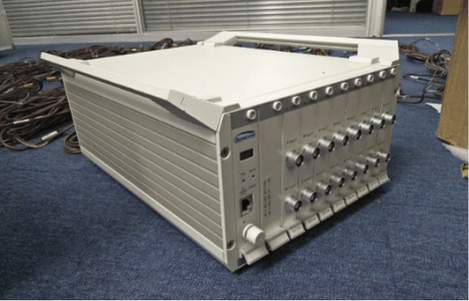Helicopter Structural Strength Testing with DE-924U
Project name: Helicopter Structural Strength Testing
A certain aircraft industrial group utilizes the Dynatronic 32-channel DE-924U Dynamic Signal Test and Analysis System to measure structural stress and displacement on its helicopters. Additionally, the system integrates video capture functionality to synchronize and store real-time test images with experimental data, enabling convenient review of operational conditions.
1. Testing Objectives
Structural Stress Analysis – Measures stress distribution under static/dynamic loads (e.g., flight maneuvers, ground resonance).
Displacement Monitoring – Tracks deformation in critical components (e.g., rotor hubs, fuselage frames).
Multi-Sensor Synchronization – Combines strain gauges, accelerometers, and LVDTs for comprehensive structural assessment.
2. DE-924U System Advantages
32-Channel High-Speed Acquisition – Supports simultaneous data collection from multiple sensors at high sampling rates.
Real-Time Data-Video Sync – Embedded video recording aligns visual inspections with test data for post-analysis validation.
Advanced Signal Processing – Features FFT, time-domain analysis, and fatigue life estimation for structural integrity evaluation.
3. Testing Workflow
Sensor Deployment
Strain gauges installed on load-bearing structures (e.g., landing gear, tail boom).
Displacement sensors (LVDTs/lasers) monitor deformation in real time.
Load Application
Ground tests simulate flight loads (e.g., static pull-up, rotor imbalance).
Environmental vibrations are recorded for resonance analysis.
Data & Video Integration
Test videos are timestamped and linked to sensor readings for cross-reference.
Automated reports highlight stress peaks and critical displacements.
4. Technical Challenges & Solutions
Complex Load Conditions → Multi-axis loading simulations with synchronized data-video feedback.
Noise in Dynamic Tests → Adaptive filtering and coherence analysis ensure signal accuracy.
Large Data Volumes → DE-924U’s high-throughput storage manages GB-level datasets efficiently.
5. Applications
Certification Testing – Validates airframe compliance with aviation safety standards.
Fault Diagnosis – Correlates stress anomalies with visual defects (e.g., cracks, buckling).
Maintenance Optimization – Identifies wear-prone areas for targeted inspections.
6. Future Enhancements
AI-Assisted Analysis – Machine learning for automatic defect detection in video-data pairs.
Wireless Sensor Networks – Reduce cabling in full-scale helicopter tests.


